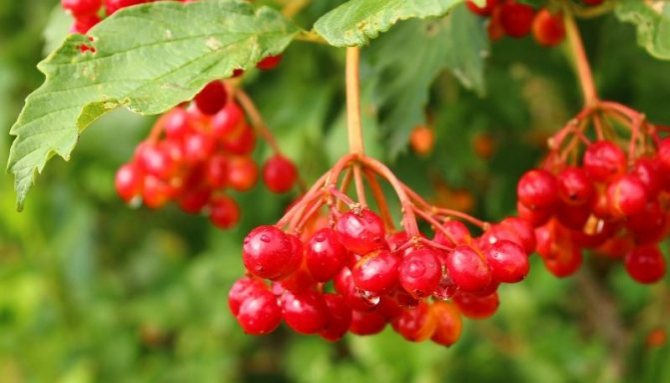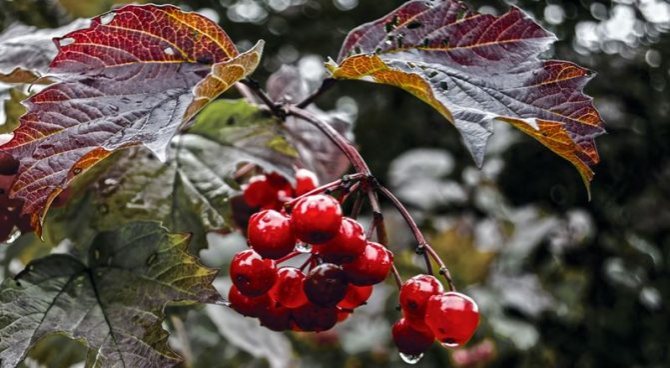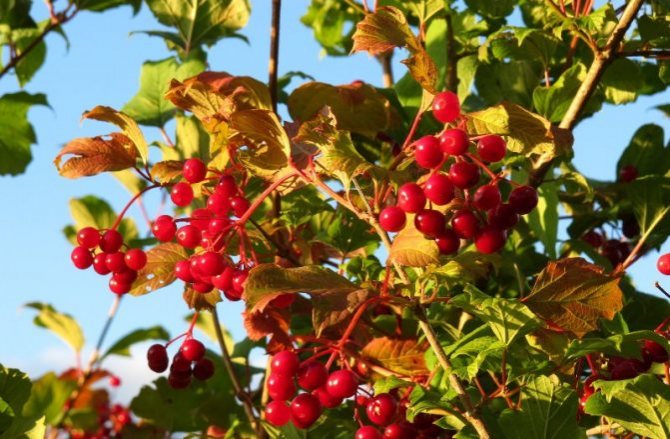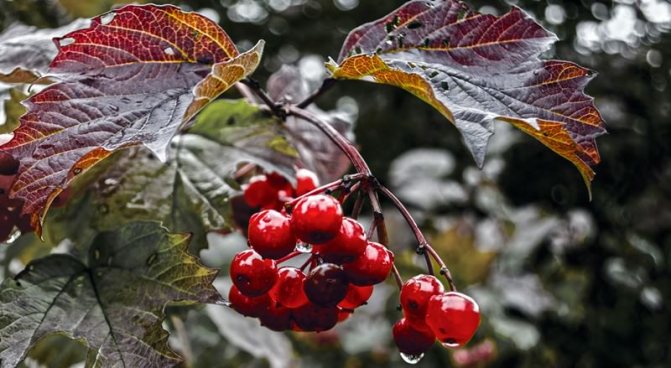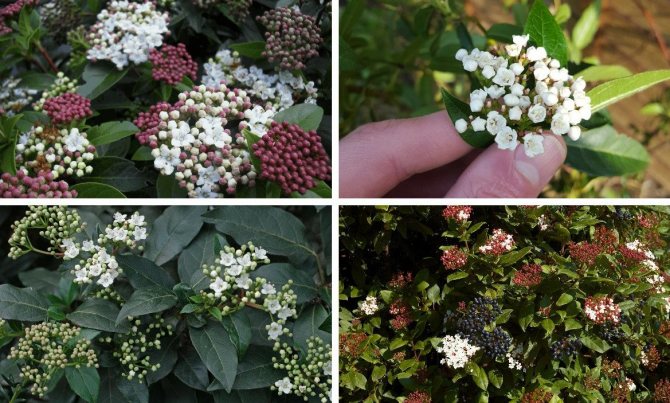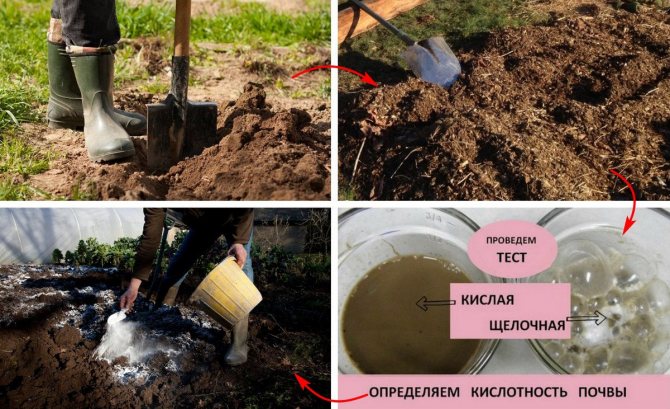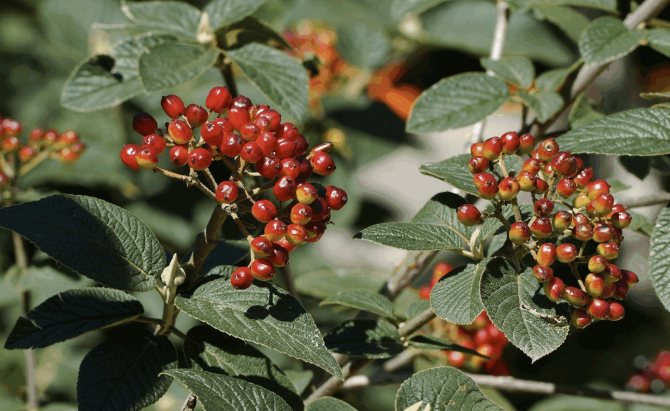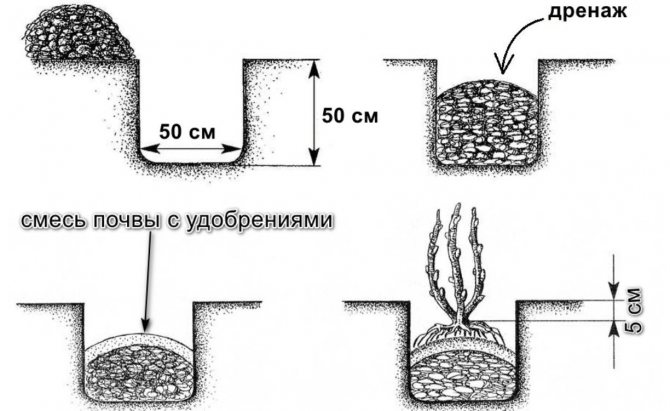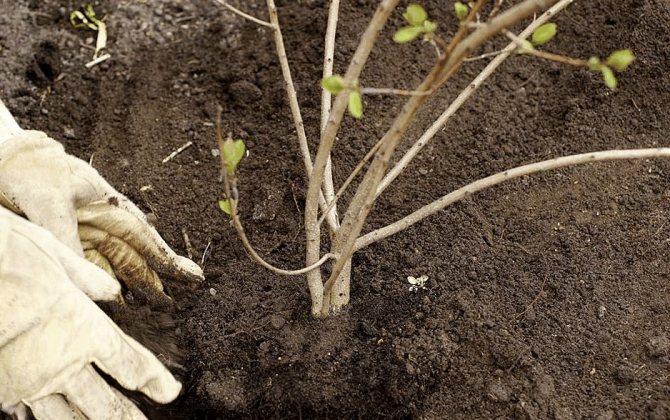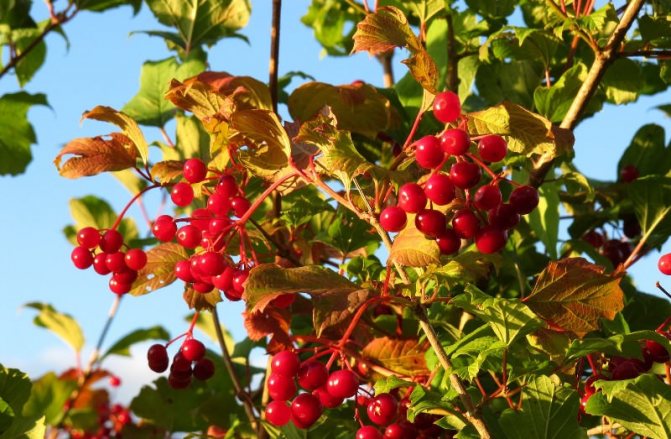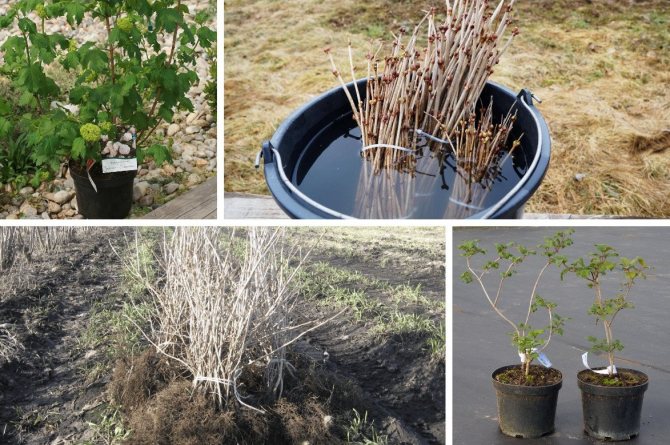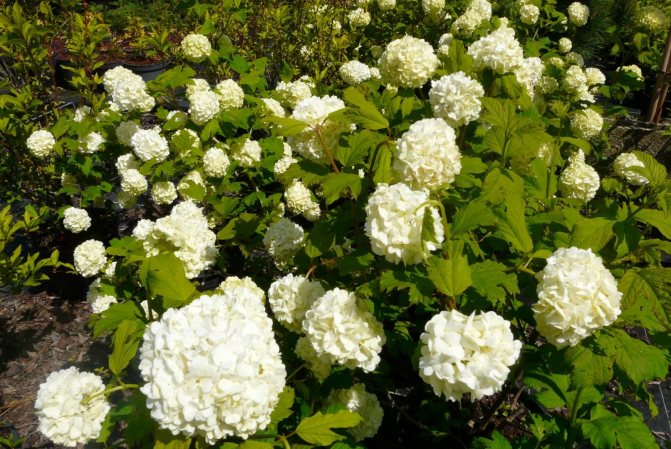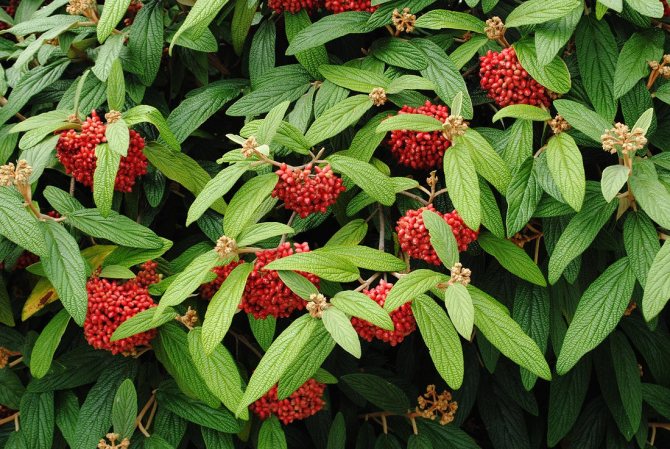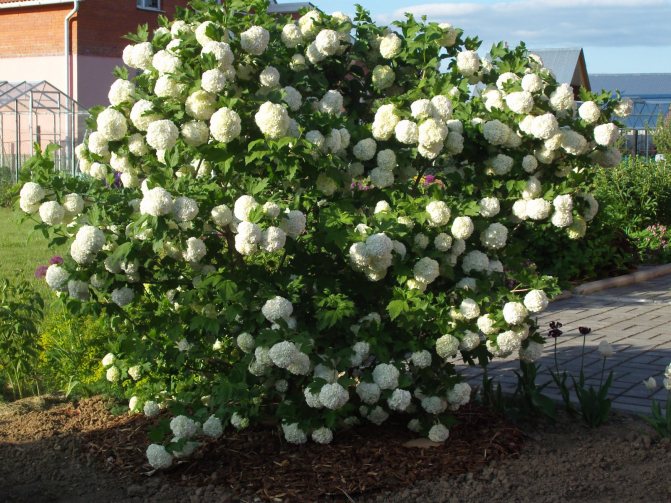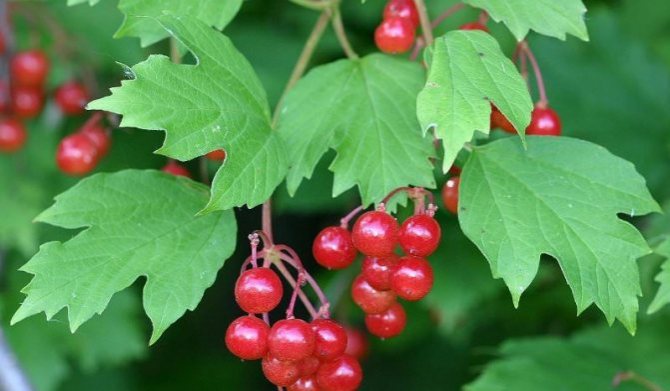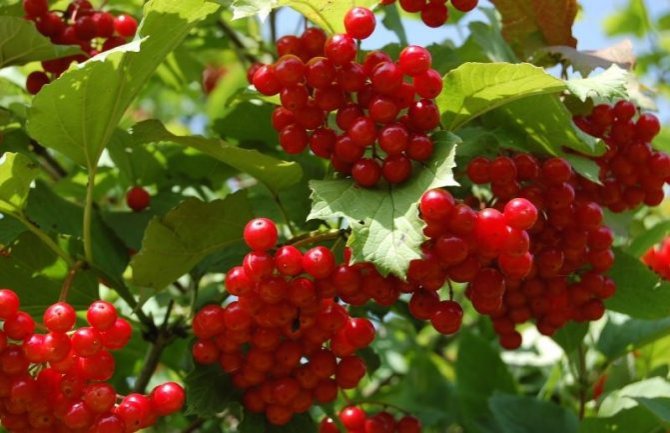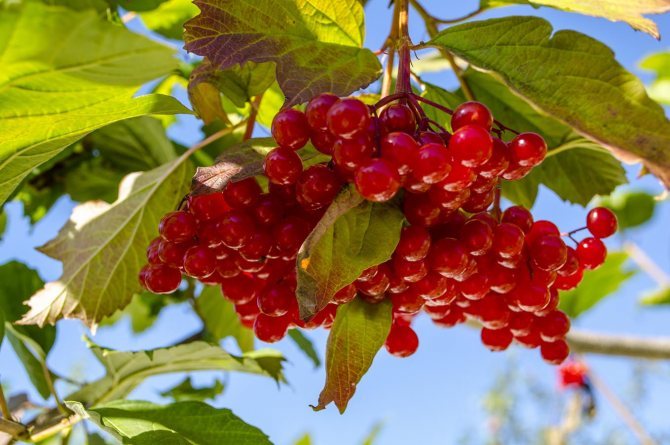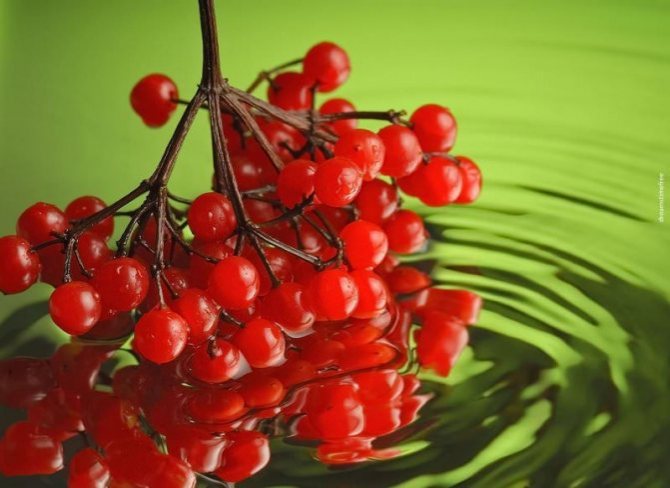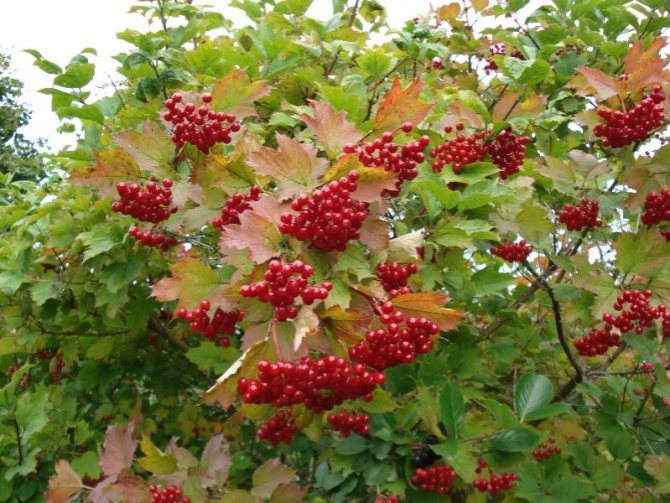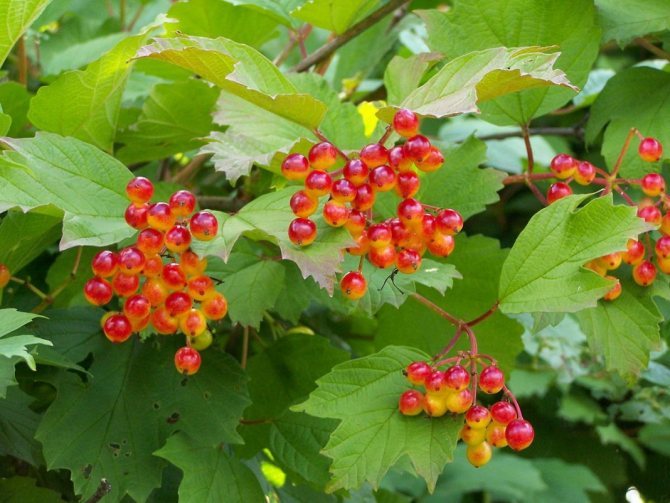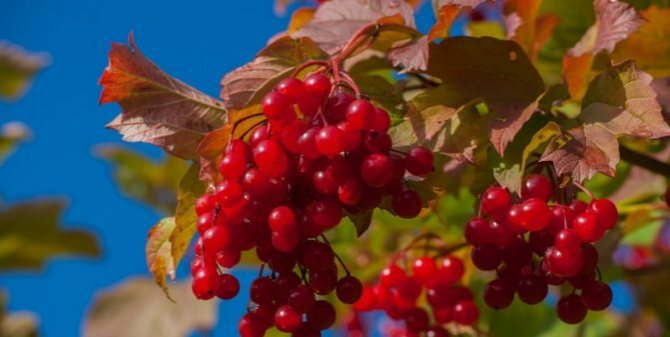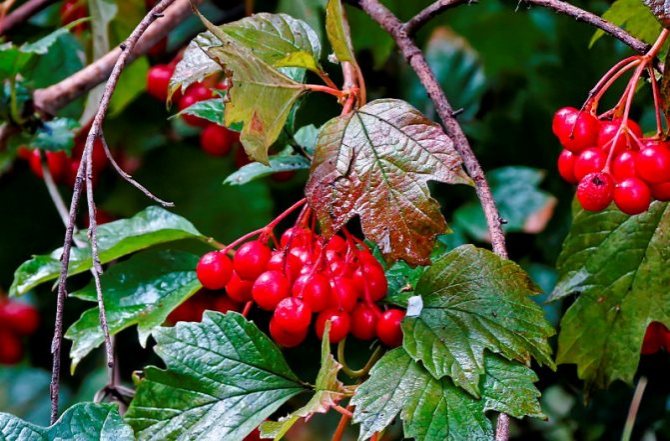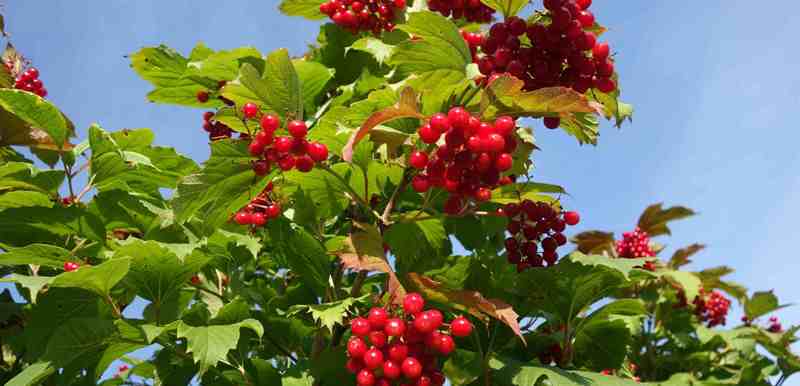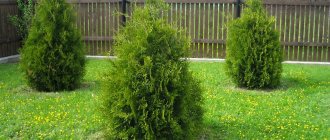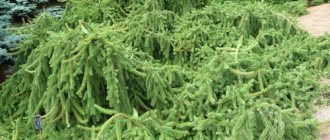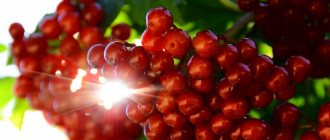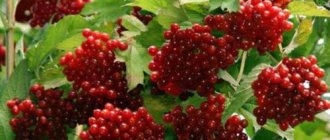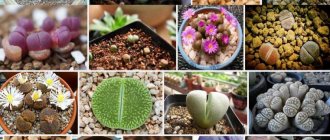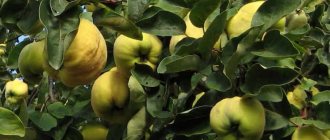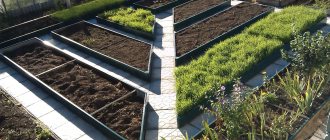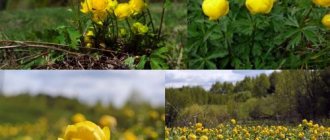Even in Ancient Russia, Kalina was revered as a special magical plant. Healers believed that viburnum bestows a good fortune on women. Therefore, it was not a wedding that was decorated with a viburnum, but young girls weaved its inflorescences into their wreaths. When the first yellow leaves begin to fall around, crimson clusters of viburnum appear in the mind, which are of great importance for any gardener, because the medicinal properties of viburnum berries are legendary. Kalina is also considered a well-known melliferous plant. And, of course, viburnum has always amazed with its beauty, creative romance and special autumn aroma. Let's figure out how the viburnum planting is and how it needs to be looked after.
Growing viburnum in the country
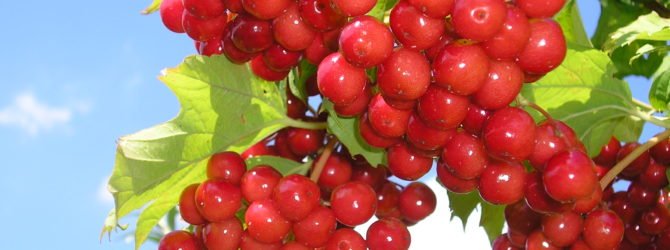
These bushes are inhabitants of almost all country gardens. And it is no coincidence: in the spring they are covered with bright white inflorescences, and in the fall, having already thrown off the foliage, even after frost, they are hung with bunches of red berries. After acquiring a plot of land for arranging a summer cottage, literally in a short time, red viburnum appeared on our site. I dug a small bush in the front garden of my father's house. Our mother loved the dacha very much, and the viburnum became her favorite flower and her favorite berry. Our mother passed away early, and in memory of her I planted a viburnum. For more than 20 years, the bush has been decorating our summer cottage, bringing invaluable help. At the beginning, I planted the viburnum right in the center of the site, because there were no other plantings yet. But as the trees and shrubs grew, they had to transplant it to the just dug well. Here the viburnum quickly began to grow, began to grow and close the well. When, after a while, a garden house was built on the site, the whole family decided that the most suitable place for our beauty was next to it, right along the facade. In this chosen place, now a large, beautiful at any time of the year, a red viburnum bush grows and pleases us for many years.
Reproduction and rooting
Viburnum can be propagated in various ways, some, such as seed propagation and cuttings, are quite laborious and are rarely used in home garden plots. Breeding viburnum takes a long time; three-year-old seedlings are used for planting.
Seeds
It is difficult to grow viburnum from seeds at home, since the germination of seeds does not exceed 20%. Viburnum seeds are washed and dried. Then they are kept for 2 months in nylon stockings stuffed with wet sawdust. Sprouted seeds are hardened for a month in the refrigerator at a temperature from 0 to +5 ° C. Then they are planted in boxes with soil. After warming up the soil, it is placed in open ground. The seedlings are placed in a permanent place after 2 years.
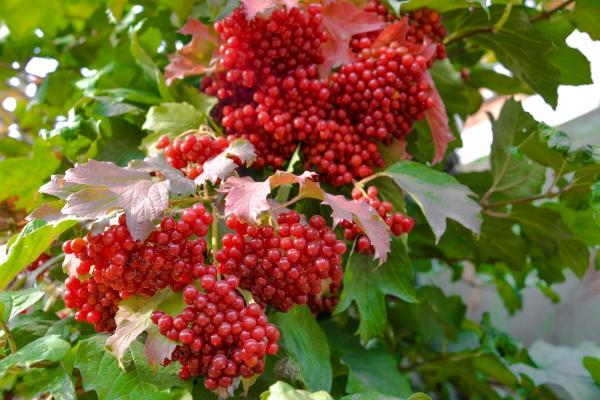

Vertical layering
After leaf fall on an adult plant, the lower branches should be pruned, leaving 3-4 buds. Then the bush is spud and left until spring. In the spring, the overgrown shoots are once again spud. When the layers grow to 20-25 centimeters, they are pulled at the bottom with wire and cut by 1/3. After 2 weeks, they huddle again. In autumn, the rooted shoot is separated and transferred to a permanent place.
Cuttings
Viburnum propagation by cuttings in the fall is carried out after the snow falls. This is done at the end of November or after the onset of winter. 20-centimeter shoots are cut from the bush.They are kept in water for 3 hours, placed in a plastic bag and left in a cool room until spring. After warming up the soil, the cuttings are planted in the ground, periodically weeded and watered, in the fall they are transferred to a permanent place.
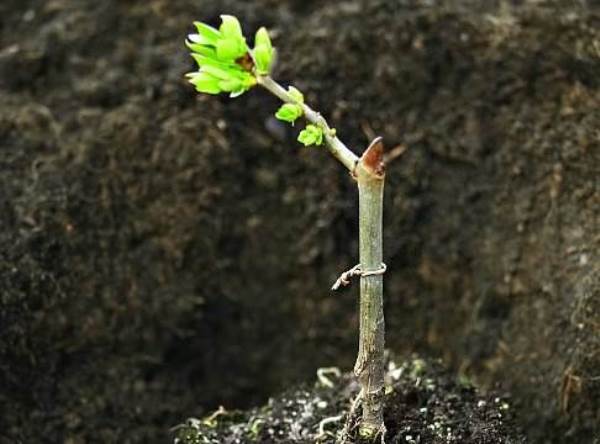

Horizontal layering
In the spring, strong shoots are bent to the ground and buried in. The shoots are "fastened" with wire, and again sprinkled with earth. After the shoots grow up, the hilling is repeated 3-4 times. The shaft height should be 25-35 centimeters. By the fall, the processes take root, they are dug up, separated, planted in the desired area.
Root shoots
In late spring or early summer, strong shoots are selected that have grown by 20-25 centimeters. They are pulled with wire at the base and spud. Hilling is carried out 2-3 more times over the summer. Then the shoot is left alone until the next spring. With the onset of heat, the rooted seedlings are transferred to a new place. It is most simple to propagate plantings of viburnum by root shoots, this is one of the most popular ways.
Reproduction of viburnum
By dividing the bush
This method is used when the variety is very valuable, so as not to lose its characteristics, or if you need to transplant the viburnum bush to a new place. In this case, you need to divide the bush into several parts, but each part should have at least three kidney renewal... The bush can be divided both in spring and autumn.
Cuttings
June - early July - it's time to harvest green cuttings. It is important that they remain flexible. They need to be cut so that each has at least 3 nodes, the length of the cutting is about 10 cm. There is an oblique cut along the bottom and the leaves are cut off.
Can be treated with growth preparations, such as root. After that, in the greenhouse, you need to bury the cuttings in the soil by 2 cm. The soil mixture consists of peat and river sand 1 to 1. The greenhouse must be covered with foil or glass to root the cuttings. They are grown for three weeks at temperatures from + 27 ° C to + 30 ° C and high humidity (70%). Young cuttings need watering (spraying).
For the winter, rooted cuttings are covered with leaves, peat or sawdust and left in the greenhouse until spring. In the spring, they are planted in the ground in a permanent place. After 2 years, young cuttings will bloom.
Layers
In the spring, you need to prepare grooves for annual shoots, put the shoot in the groove and sprinkle it with earth, attach with wire, the top of the shoot should not be buried. Above the place where the earth is poured, you need to wire the shoot and cut it. By the fall, roots will appear on such horizontal layers, buds will give young new shoots, then such shoots are cut off from the mother plant and planted in a permanent place in the garden.
Viburnum seeds are rarely propagated, since seedlings appear after a long time, one and a half to two years, and the berries are bitter and small, in small clusters.
Natural watering and good lighting
Not far from the viburnum there is a drainpipe from the roof. The side where the viburnum grows is the southern one. And the fact that viburnum is moisture-loving and needs good lighting, we have already studied earlier. Therefore, every year we see the lush flowering of the viburnum, and its abundant fruiting. Watering is obtained naturally - with rainwater, and mineral fertilizing (urea - 30-40 g, complex mineral fertilizer - 70-80 g) is done no more than twice a year. We feed once in spring and late autumn. Since the viburnum bush has become quite large, every year in the fall I do thinning (sanitary) pruning. I remove mostly older branches (6-7 years old). Branches that intertwine or have cracks, breaks, I cut off in early spring for the reason that in the fall they still have some berries for the birds. To make the viburnum bloom more magnificently, I pinch the strongly growing young branches when they reach a length of 25-30 cm.
Pruning
You can prune the plant both in autumn and early spring.Kalina definitely needs sanitary and rejuvenating pruning. In addition, pruning forms the volume of the plant. Pruning in early spring each year limits the size of the shrub and increases the light in the crown. Weak diseased branches are also removed.
This is interesting: Symptoms of ear diseases
Next, the old 7-9-year-old branches are cut out, which have already borne fruit. Only strong, annuals are left. Low flowering bushes are cut completely. Stumps remain, protruding 15-20 cm above the ground. Sleeping buds give young shoots and viburnum very soon recovers.
If the plant is grown for fruit, the inflorescences at the edge of the shoots should not be shortened to avoid loss of yield.
When the bush is not cut for a long time, it thickens, loses its beauty. Rejuvenating pruning is done after the kidneys have awakened. Old branches are cut or cut with pruning shears, small hemp five centimeters long remain. Young shoots appear from the stumps. Over the summer, weak branches are removed on the shoots.
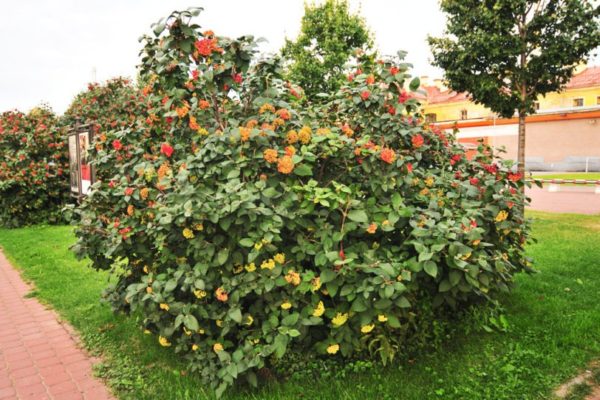

Overgrown viburnum bush, requiring pruning
Growing viburnum: the basics of caring for a shrub
Viburnum is a moisture-loving plant, because it is not for nothing that she prefers shady places. Therefore, one of the most important maintenance measures is regular watering, at least 2 times a week.
In addition, viburnum needs:
- Feed. In the spring, nitrogen preparations are used to stimulate growth. From the second half of the summer, in order to get a harvest of medicinal berries, they switch to potassium-phosphorus fertilizers.
- Form. Viburnum grows in the form of a bush and you can leave this form, thinning the crown annually. Another perennial is formed in the form of a tree, leaving one shoot and cutting out the rest. For several years, the trunk is grown, and when it reaches a height of about 1 m, the crown of the tree begins to form.
As you can see, the cultivation of viburnum will not cause much trouble, but it will delight you with a beautiful shrub and a medicinal harvest.
Video about growing viburnum
How to propagate a culture
Sometimes there is no direct need to propagate viburnum in its own area, since it has the ability to self-pollinate. However, if such a need arose, there are several ways to propagate a tree:
- vertical layering;
- horizontal layering;
- cuttings;
- seeds.
Propagation by vertical and horizontal layers is quite simple. In the first case, in the spring, the shoots are spud up by 10-15 cm, in the second, they bend the shoot and cover its middle part with soil, over the summer, new roots are formed on the buried parts of the viburnum.
Has the ability to self-pollinate
Viburnum cuttings have a more complex process that requires special devices and substances for the future stimulation of root formation. It is used when you need to get a large number of plants at once, which cannot be achieved by layering.
Pest control
When caring for viburnum, it is very important not to miss the moments when aphids appear on the leaves in spring and summer, and especially leaf beetles. These pests can greatly spoil the appearance of the viburnum in a short time and negatively affect the yield of berries. To prevent the appearance and reproduction of leaf-gnawing caterpillars, to enable the viburnum to form a crop, every year, before budding, the bush must be treated with chemicals. During flowering and ripening of fruits, viburnum is best treated with herbal infusions or decoctions (red hot pepper, garlic, marigolds, calendula, bitter wormwood, tomato shoots). In my work, I very rarely treat trees, berry bushes, including viburnum, with chemicals. “A garden without chemicals” is my slogan in this matter. And on our site, and throughout the garden partnership, there are enough plants and herbs, which in full make it possible to protect the garden and vegetable garden from pests. The necessary herbs need to be harvested for future use, they can be stored for 2-3 years.And if you add laundry soap, infusion of ash, dried peels of orange, lemon, tangerine and a number of other additives to them, a good harvest of viburnum, like other berries and fruits, will be ensured. Both beauty and medicine Kalina is an ornamental plant. It is beautiful both during the flowering period (end of May - June) and during fruiting. The flowers of the viburnum are white, fragrant, collected in large umbrellas, The flowering bush of the viburnum is visible from afar, and its smell attracts both a person and a hardworking bee. In winter, when there is snow and frost all around, bright red clusters of viburnum decorate the dacha. Bunch fruits are firmly held on the branches during autumn and winter. Viburnum is a special medicinal plant, because everything has healing properties: flowers, fruits and even bark. We use fresh fruits as a vitamin and general tonic. But we especially love viburnum, which is seized by a light frost. We cut off its bunches, tie them into bunches and store them hanging on the balcony. Tea made from such a viburnum, and just berries scalded with boiling water, are a real pleasure and a good medicine for many ailments. Viburnum from one of our bush is enough for us (my wife and I), and the families of our two daughters. Every year we leave part of the viburnum bunches on the plant. In addition to the beauty, which I have already said, the red viburnum helps to endure the winter cold for many of our feathered assistants. After all, they, birds, like us, do not forget our beautiful summer cottage either in summer or in winter. For this, we always try to thank them in return. Plant and grow at least one red viburnum bush, it's worth it!
Experienced gardening tips
- with an invasion of ants on viburnum, it is worth treating it with an insecticide;
- at the end of the leaf fall, all fallen leaves should be removed in conjunction with the old layer of mulching;
- after the stem of the culture is formed, it must be tied up in order to avoid damage in case of strong gusts of wind;
- during the summer period, at least two hilling should be carried out.
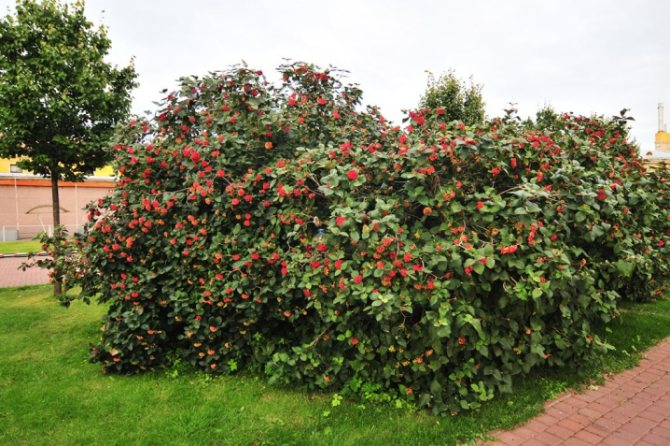

Almost everyone can grow a viburnum bush on their own plot. Culture can become not only a worthy decoration of the garden, but also a source of essential elements for the human body. The beneficial substances of viburnum berries can help with colds, insomnia, and hypertension. The berries of this plant should be picked after the onset of the first frosty days and stored in grated, frozen or dried form.
More information about planting and caring for viburnum can be found in the video below.
Viburnum is most often associated with medicines of natural origin for colds, less often, but often, decoration and "amulet" of the garden. Literary works praise the cultivation of viburnum trees, romanticizing its appearance.
Viburnum diseases and pests
What is the viburnum sick with?
In general, viburnum rarely gets sick, but this happens, especially in certain years, when this or that disease suddenly manifests itself in a particularly strong degree.
In humid years, with an abundance of heat, in thickened stands, where no pruning is carried out, outbreaks are frequent powdery mildew... This is a fungal infection that manifests itself in the form of a whitish plaque on the leaf blades of the viburnum, which turns brown over time (when the spores mature and scatter in different directions). Mealy growth, developing, leads to drying out and death of leaf blades, therefore, the processes of photosynthesis are disrupted, the yield decreases.
It is possible to combat powdery mildew on viburnum by treating with colloidal sulfur in an amount of 50 g per 10 liters of water, the consumption rate of the drug is about a liter per plant. To cope with powdery mildew will also help drugs that are called fungicides, for example, Skor, Topaz and many others.
Ascochitous spot, - it appears on the leaves of the viburnum in the form of angular spots or spots of a round shape, grayish in color, with a purple or brown border. Over time, in the place where the spots were, foci of dead tissue appear, which lead to the death of the entire leaf blade.
To exclude the recurrence of the disease, it is imperative to collect and destroy the fallen leaves. They help Kalina to cope with the disease by treatment with HOM or 2% Bordeaux liquid.
Often, especially when the summer period is characterized by low temperatures and an abundance of precipitation, it appears on the leaf blades of viburnum. gray rot... Signs of this disease are brown, shapeless spots on the leaves of the viburnum, which grow over time, sometimes covering most of the leaf. The leaf tissue in the place of these spots dries up and falls out, the berries can also be affected by gray rot, while they are covered with a brown bloom and rot.
To exclude the appearance of gray rot on the viburnum, it is necessary to abandon watering if it rains, do not thicken the plants, carry out sanitary cleaning of the crown, always collect all the fruits from the bushes and remove foliage and plant residues in the bite zone. Treatments with any fungicides help.
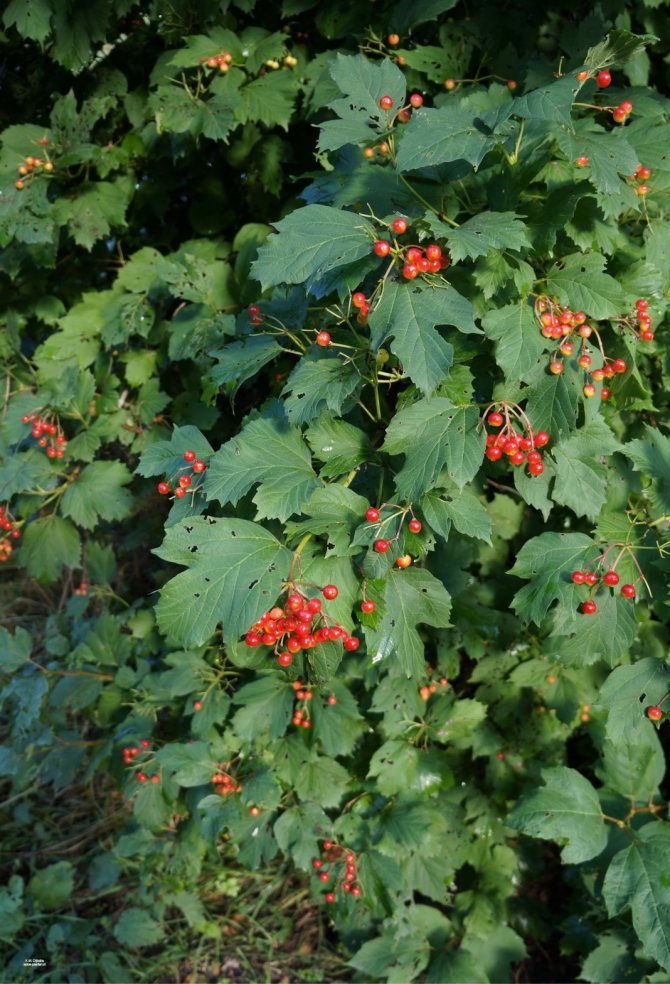

Viburnum bush with berries.
General characteristics and description of viburnum
A resident of the forest-steppe and steppe zones - viburnum - prefers moist soils, grows along river banks, survives frosty winters well, the bush can reach 3 meters in height. Viburnum is a perennial shrub from the genus Adoksovyh, it grows in Europe, Asia and some African countries.
The flexible branches of the viburnum have long been used for weaving baskets, the first mention of the medicinal properties of the plant dates back to the 16th century. There are about 200 species of viburnum, a plant with large-toothed bright green or reddish leaves and large clusters of bright red (sometimes black or yellow berries), is used as an ornamental shrub, thanks to a branched root system, it is planted to strengthen the soil on slopes, is used as a living hedges.
White or slightly pinkish inflorescences resemble balls with a diameter of more than 12 centimeters, flowering occurs in May.
Berries are very rich in vitamins (there is more vitamin C in viburnum than in lemon), they are used to lower blood pressure, improve digestion, eliminate edema, and are used as a general tonic and medicine. Each berry contains a large flat seed, colored in the color of the fruit's pulp. For medicinal purposes, the bark and berries of the plant are used.
Description
Viburnum is really quite a beautiful tree, the fruits of which have many beneficial effects for the body and protection from some pests. The tree grows up to 4 m, has a highly developed root system and is shade-tolerant and frost-resistant. The bark has a wrinkled brown-gray texture. Leaves are rounded, large-toothed.
Viburnum can bloom mainly in May-June. Duration of flowering up to 3 weeks. The flowers are white, collected in corymbose inflorescences. The marginal flowers of the inflorescence are used to attract insects, therefore they are sterile, and the fruits are tied on smaller middle flowers.
Fruit color ranges from red to brown
The viburnum tree begins to bear fruit at the age of 5-6, and the peak yield occurs by the age of 12. The tree can withstand frosts down to -35 ° С, as in the Urals, and the berries are preserved on it until spring. Viburnum berries are spherical and collected in a brush. The color of the fruit varies from red to brown, almost black, depending on the type of tree. The seed of the berry is small, flat. The berries are bitter to taste. However, if you remove them after frost and process them with sugar or honey, then the bitterness disappears.
Viburnum fruits have a useful composition of:
- vitamins C, P;
- carotene;
- valeric, formic, acetic acid;
- Sahara.
Such a berry is useful for people with problems:
- liver;
- gallbladder;
- brain;
- hearts;
- vessels;
- skin;
- nervous, digestive and even reproductive systems.
Viburnum juice normalizes heart function, pulse, lowers blood pressure and has a diuretic and choleretic effect.
Types and varieties of viburnum
It can be deciduous or evergreen, any of the species has excellent decorative characteristics. The most popular varieties:
- Viburnum ordinary. A tall, deciduous shrub with very beautiful snow-white buds and bright scarlet clusters of berries.
- Kalina Bulldonezh. An ornamental shrub that does not produce berries. Snow-white balls of inflorescences decorate the site, often used in landscape design.
- Kalina Wright. The species is included in the Russian "Red Book". The fruits are perfectly stored and transported, the bush can reach a height of 2-3 meters, it tolerates frost well, and is able to grow in shaded areas.
- Kalina Canadian. The berries of this plant are black. A bush with large, wide green leaves that turn reddish in autumn. Excellent for growing in the city, easily tolerates heavy city air, saturated with harmful substances.
- Viburnum Folded. Ornamental shrub with inedible berries. The lamellar spreading crown, in which during the flowering period the dark green leaves are shaded with snow-white flowers, looks very impressive, in the fall the foliage acquires a spectrum of shades (yellow, reddish), the berries change richly crimson to black.
- Kalina Gordovina. A decorative type of viburnum, grows slowly, is often used for landscape design. Ripe black berries are edible, but they do not ripen at the same time; planting is actively used to strengthen the soil.
- Viburnum ordinary Xanthocarpum is a yellow-fruited variety, the berries do not differ in taste from the red viburnum. The foliage remains green almost until the leaves fall. Together with red viburnum, it makes a gorgeous decorative composition.
There are several sweet-fruited varieties of viburnum, in which there is much less bitterness. For example, Ulgen or Taiga rubies. These berries can be eaten directly from the bush, without waiting for them to be "caught" by the frost.
Important: one should not expect that there is no bitterness in such varieties at all, it is simply much less in comparison with other species.
Kalina is distinguished by unpretentiousness, high decorativeness of the bushes, medicinal value of berries.
Possible growing problems
For novice gardeners in the Moscow region and other regions, information about the possible difficulties that arise when growing viburnum is very important. The most common problem is the damage to the plant by pests and diseases that can be eliminated with the help of special means. In a situation where the culture does not give inflorescences, it is worth considering whether the choice of the planting site has been made correctly. When growing a plant in a shaded area, its decorative effect may suffer. Drought or severe winters can also result in the absence or reduction of buds on the bush.
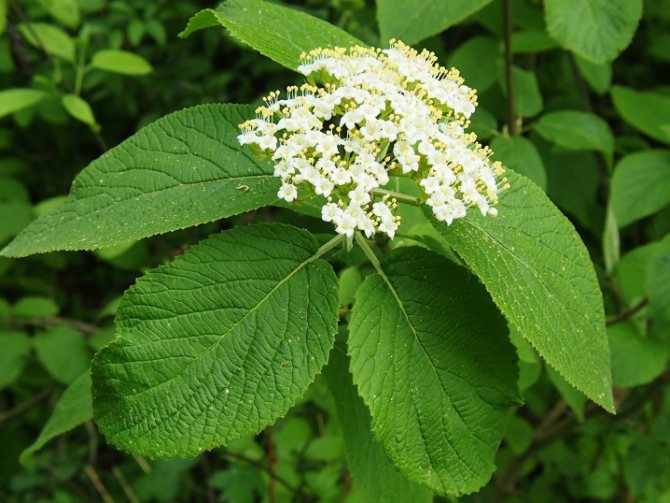

Pruning and shaping the plant
How the viburnum will grow - a shrub or a small tree - depends on you. If there is free space on the site, the viburnum is left to grow in the form of a bush. In order for the plant to bear fruit well, the length of the branches is shortened to 40 cm.As soon as the first warmth comes in the spring, it is necessary to prune the useless branches in order to renew the bush and thin it out.
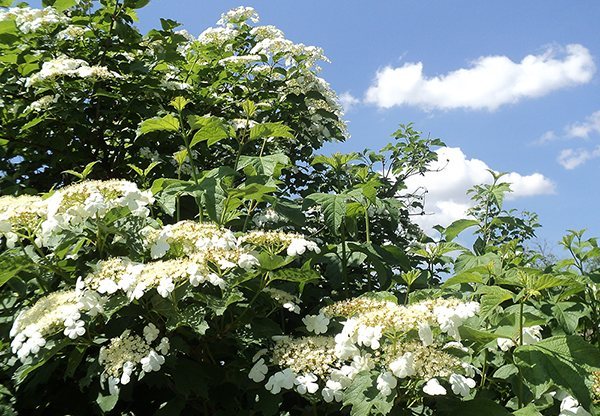

If there is not much space and every square meter is expensive - viburnum can be formed in the form of a tree. This process can be started already in the second year of the plant's life. For this, all young branches are cut from the bottom to a certain height (usually about 1 m). In the future, all shoots up to this level will need to be plucked out regardless of the season (pinching).After 3 years, the viburnum will be formed like a tree, the top will need to be shortened, then the crown will gradually grow and become more magnificent.
After the harvest is harvested, autumn pruning is carried out. Its purpose is to remove all dry and affected branches, as well as dried out brushes.
Formation
Unlike other fruit shrubs, viburnum does not require frequent pruning of shoots. Shoots are usually removed once a year.
When a plant is formed by a bush, in the spring all branches are removed by 2-3 nodes. Growth points are pinched when they reach a length of 30 cm. Awakened buds will give young shoots. They will be the main component of the plant. IN in subsequent years, systematic pruning of the viburnum will form the desired size of the bush.
If you want to see the viburnum as a tree, at the beginning of the formation you need to leave the vertical central trunk. The rest of the side branches should be removed. The shoots around the bush are also cut off. After 2-3 years, a trunk with a height of about two meters will form. The crown is formed by pinching the growth point. The tip of the guidewire is cut off and several buds appear at the cut site. Thanks to this procedure, the tree becomes branched.
It is not difficult to grow viburnum on your own site. You need to be able to competently take care of her. Then the plant will delight you with magnificent flowers and beautiful healthy berries.
How to grow viburnum on your site
White clusters of inflorescences, crimson autumn foliage and ruby clusters of viburnum berries are of particular importance to Ukrainians. This is obvious from the reverent attitude of the people to the plant in toponymy, literary and artistic creation. In general, the culture is valued not only for its beauty and nutritional qualities, many people know about its medicinal and melliferous properties. She will be a good judge in the courtyard of a creative romantic and economic practitioner. Let's figure out in more detail where to plant viburnum on the site, how to care for it.
Description of culture
Due to the fact that this culture does not have high growth, many classify it as an ornamental shrub. The plant has a thin and branched trunk with a spreading crown, large leaves and white inflorescences that bloom in the garden in the second decade of May. Kalina is called decorative for a reason, the duration of its flowering is more than 1.5 months and this criterion is more than used by landscape designers in creating harmonious gardens. In addition to the long flowering of white inflorescences, this tree pampers with blood-red fruits. In autumn they ripen, but they can hang on a tree until winter, striking with beauty and emphasizing the snowy whiteness of winter. Moreover, with frost, viburnum berries only become tastier.
Viburnum fruits
How and when to pick viburnum berries
In the Moscow region, viburnum berries begin to be picked in the first half of October. Dry berries should get into the basket, so do not rush if it has recently rained. In dry weather, it is better to collect viburnum after 9 am, when the night dew has already disappeared from the berries, but without waiting for noon. An equally suitable time is evening or throughout the day, if the sun does not come out from behind the clouds.
Viburnum clusters are carefully cut with grape scissors and put in a basket or special bags for harvesting.
Growing this valuable shrub is practically no hassle, it will decorate any site in spring, summer and autumn. Among the positive aspects, in addition to the undoubted benefits of berries, it should be noted the rapid growth of this plant, the beautiful appearance and aroma of its flowers.
General description of the shrub
The charming name of the viburnum has French roots - Boule de Neige translates as “snow globe”. And this is exactly the case when the name fully characterizes the appearance. The plant is valued not only because of the flowers, but also because of the beautiful leaves. Due to its beauty and sophistication, the plant is often used in landscape design and in ordinary summer cottages.
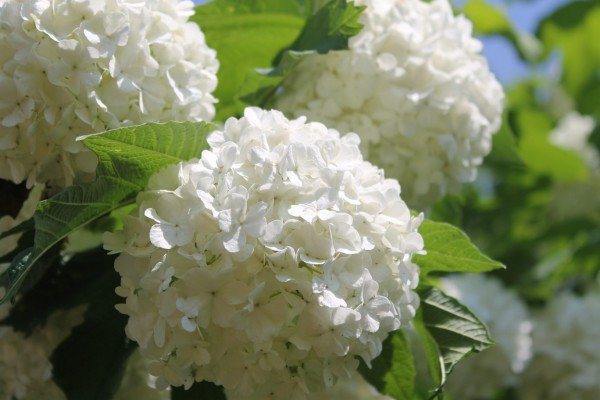

The average height of the shrub is from two to three or three and a half meters. Flowers can grow up to fifteen centimeters in diameter. With proper cultivation, regular and systematic care, the shrub can live up to fifty years.
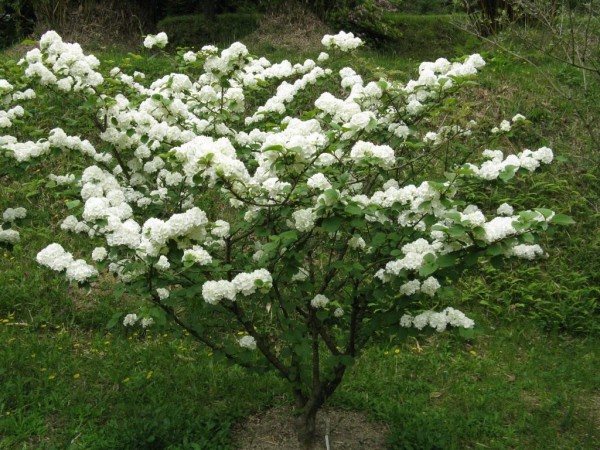

The flowering period of viburnum - from late spring to early summer, blooms most often within two to three weeks. Due to the abundance of large snow balls, the branches become heavier, so in some cases they need to be propped up so that they do not break.
An interesting feature of the plant is that the flowers are odorless.
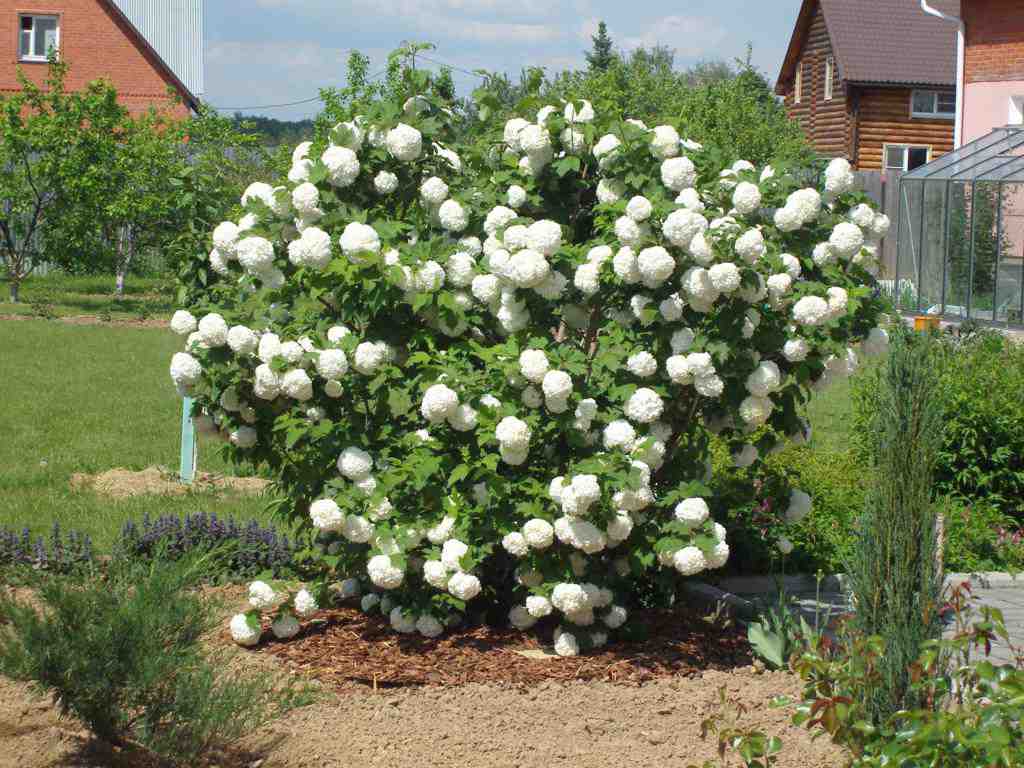

Planting and replanting Kalina Buldenezh can be either next to other crops or in splendid isolation. In both the first and second versions, it will look interesting.
Video: plant description
How to choose quality seedlings
It turns out that thanks to the efforts of breeders, the culture we are used to today differs from that sung in folk art and is very diverse. Therefore, first you need to decide what exactly you want to see in your garden. You will have to choose from decorative varieties, which never have berries, fruitful, tree-like or bush-like, tall, dwarf and ground cover species.
All roots must be fresh, even, smooth and clean. To make sure the seedling is fresh, lightly scratch the bottom of the rootstock. If fresh greenish wood appears at the site of the wound, it means that the viburnum is suitable for planting.
Its shoots must also look healthy. Choose small specimens, as they take root faster and more easily adapt to new conditions, and are easy to care for. Experts respond positively to the seedlings obtained by the vegetative method. They say that such samples begin to bear fruit already in the second year after planting, it is advised that when planting a plant at home, it is advisable to prefer exclusively the seed method. They also recommend choosing two-, three-year-old seedlings for planting.
Viburnum in the garden: growing, care and useful properties
10 October 2020, 07:55
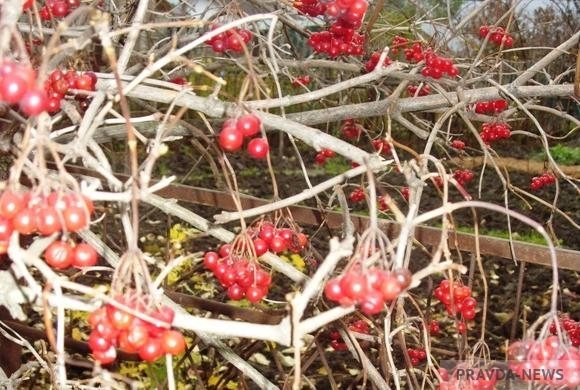

Our ancestors considered viburnum a symbol of youth and beauty. Legends, songs and poems were composed about her. Its healing power has been used in folk medicine. This useful, amazing plant has not been forgotten even now. Only now it is not as widespread as, say, currants or raspberries. Although it is perfect for growing in a summer cottage and does not require any special worries.
Viburnum is attractive for gardeners and the fact that 2-3 years after planting it begins to bear fruit and yields a harvest for 20-25 years.
Landing
Most varieties of viburnum are self-fertile, so you need to plant at least two seedlings. The optimal planting time is autumn (September - early October) or spring (before bud break). Under the viburnum, well-lit, lowered, most moisture-rich areas are allotted - with a close occurrence of groundwater or with good irrigation. Viburnum prefers slightly acidic soils. It grows poorly on sandy, podzolic and peaty. The plant is shade-tolerant, but it blooms and bears fruit better in open places, it tolerates winter frosts, city conditions, and gas pollution well. One- or two-year-old seedlings are planted in pits 50-60 cm deep and 60 cm in diameter with a distance between the bushes of at least 2 m. 10 kg of humus, 35-50 g of superphosphate, 25-30 g of potassium salt, 200 g of wood ash and mix well with the top fertile soil layer. When planting, the root collar of seedlings is deepened by 5–7 cm and it is made sure that the roots are directed vertically downward. The soil around the plant is compacted, watered at the rate of 10 liters under a bush and mulched with peat or humus.
Viburnum care - weed removal, loosening, mulching. In dry years, watering is required - 2-3 times per summer. In the spring they feed it with infusion of mullein, diluted with water in a ratio of 1: 3, or ammonium nitrate (15–20 g / sq. M), in late July - early August with nitrophosphate (20–30 g / sq. M). Once every 2-3 years, 4-6 kg / sq.m of rotted manure or compost, 30-50 g / sq. m of superphosphate, 20-30 g / sq. m of potassium salt.
Formation
Viburnum is formed in the form of a bush with 5-7 developed branches of different ages. Weak basal shoots are cut out at the base. Fruiting bushes are pruned annually, removing weakened, broken, thickening and improperly growing branches and shoots. As the bush ages, the growth of shoots decreases, the size of the inflorescences, the number and weight of fruits decrease. Such branches, starting from the age of 7-9 years of age, are annually cut out 2-3, replacing with strong one-year basal shoots.
Reproduction
Viburnum is propagated by dividing the bush, seeds, basal shoots, layering, green and lignified cuttings. The easiest way is to use root growth. In late May - early June, when the basal shoots reach a height of 20 cm, they are pulled at the base with three loops of soft wire (to accelerate root formation), and then they are covered with earth, bringing the height of the mound by the end of summer to 15–20 cm. The next spring or autumn shoots are separated from the mother plant and planted on the site.
The division of the bush is used when transplanting viburnum to a new place or when propagating a particularly valuable form or variety. With seed propagation, the varietal characteristics of the viburnum are not preserved.
Cleaning
Viburnum fruits are harvested during full ripening (early varieties - in early September, late - in October), when they are filled with juice, become soft and transparent. The berries collected by the shields can be stored fresh for a long time in attics, balconies, verandas, in sheds. The berries hang on the branches for a long time, without losing their usefulness and taste. Sometimes they are specially kept until the first frost to reduce bitterness.
Advice for gardeners
Very often, viburnum is damaged by aphids. They get rid of the pest with the help of folk remedies - infusion of celandine or garlic: pour 300-400 g of fresh flowering plants of celandine in 1 liter of water, leave for a day, then strain and add a little laundry soap; 20-30 g of chopped chives pour 10 liters of water, stir, leave for 24 hours and strain through cheesecloth.
RECIPES
The beneficial properties of viburnum have been known to Russian people for a long time. She was harvested in late autumn, tied the inflorescences in bunches and hung out in the attic or right on the street. And then the frozen berry was used as a vitamin supplement in pie fillings, jelly, fruit drinks and compotes.
With the help of viburnum, they treated inflammation of the upper respiratory tract, hypertension, childhood scrofula and other diseases. For medicinal drugs, not only berries were harvested, but also bark, leaves, and plant shoots.
What is the healing power of viburnum? Berries contain a unique complex of useful substances: vitamins A, C, K, P, iron, phosphorus, acids - valerian, acetic, amino acids, essential oils, pectin and tannins, phytoncides.
Rich in vitamin C and phytoncides, the berry is widely used to treat colds. Kalina is recommended to be included in the daily diet for people suffering from bronchial asthma, atherosclerosis, gastritis, colitis, duodenal ulcers and stomach ulcers.
Infusions and vitamin teas from this berry also help with vascular spasms, nosebleeds. Viburnum is an excellent anti-inflammatory and choleretic agent. Decoctions from it have a beneficial effect on the functioning of the liver, heart, strengthen the nervous system.
Viburnum infusion
Pour 15-20 g of berries with 1 glass of boiling water. Insist for half an hour, then strain. Take during the day in three divided doses for pain in the heart.
Viburnum berry decoction
Squeeze the juice from 1 kg of pure viburnum berries, pour into a deep dish (enamel or ceramic). Pour the pulp with 200 g of water, put on fire, bring to a boil and simmer for 15 minutes. Strain the resulting broth and combine with juice.Add 200 g of sugar and stir the mixture thoroughly. Drink chilled after each meal for 1/3 cup for peptic ulcer disease.
Viburnum bark decoction
1 tbsp. l. Pour 1 glass of cold water into chopped viburnum bark, bring to a boil and cook over low heat for 10 minutes. Cool, drain. With this broth, regularly, several times a day, wipe the skin of the hands and feet with excessive sweating.
Honey drink with viburnum berries
You will need: 1 kg of berries, 200 g of sugar, 200 ml of water, 2 tbsp. l. honey. Squeeze the juice from the berries, pour the pulp with water and boil for 5-10 minutes. Strain the finished broth, pour it into the squeezed juice, add sugar. Stir the mixture, add honey and mix again. Take 3 times a day for 1-2 tbsp. l. 30 minutes before meals to lower blood pressure.
Found a mistake - select the text with an error and press CTRL + ENTER
Further care
Regular care for viburnum includes the following activities.
Weekly watering
Its abundance depends on the age of the bush and the weather conditions of the season. As a general rule, the soil should be moistened 40 cm deep.
Water the viburnum in the evening, avoiding long breaks between procedures.
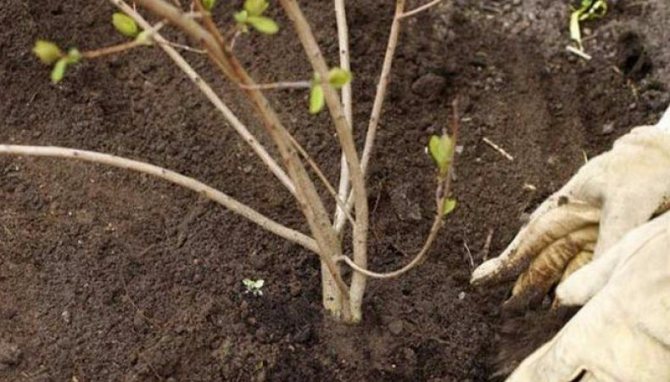

Dry fertilizers are used:
- The first carried out along the spring buds or during the opening of the foliage. Under each bush make 1.5-2 tbsp. l. urea, evenly spreading over the surface, then watered abundantly.
- The second - before the flowering of viburnum. Must contain potassium. For example, 2 tbsp. l. potassium sulfate or 500 ml of wood ash.
- Third - after the plant has faded. During this period, complex mineral fertilizers - "Nitroammofoska", "Nitrofoska" showed themselves well. The norm is 2 tbsp. l. on the bush.
- Fourth - when preparing viburnum for wintering. A solution of superphosphate and potassium sulfate (2 tablespoons per 10 liters of water) is suitable, and as an alternative - mulching the trunk circle with a layer of manure or compost.
Other activities
Kalina also needs:
- Periodic loosening soil and weeding.
- Mulching. It protects the root system from temperature extremes and prevents weeds. For mulch, tree bark, wood chips or peat are used.
- Preventive spraying fungicides for various diseases and insecticides against pests. Viburnum most often suffers from powdery mildew, ascochitous spot, gray and fruit rot. Among the malicious pests are the viburnum leaf beetle, black leaf-rolling aphid, viburnum leafworm, viburnum and honeysuckle gall midges, green lobed moth.
- Pruning. Rejuvenating and shaping are carried out in early spring before the juices begin to move. Sanitary - in the fall, after dropping the crown, but before the onset of frost.
Seat selection
When thinking about a suitable area for viburnum, keep in mind that it is very demanding on soil fertility and lighting.
Lighting
The culture prefers to grow in an open area with good lighting or in a little shade. For viburnum, an excellent option would be a utility yard, where luxurious bushes will hide unsightly buildings.
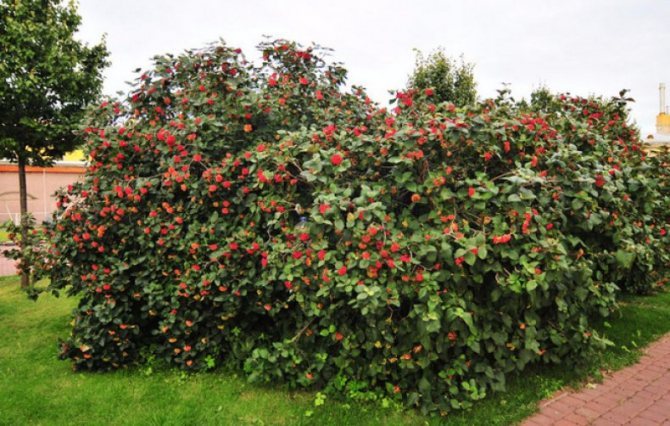

The soil
Regardless of species and varietal differences, viburnum quickly takes root and grows well on light nutrient-rich soils with a neutral or slightly acidic pH reaction.
The main thing is that the selected area is not damp, since stagnant water during a thaw or in bad weather will have a detrimental effect on the plant. Well-loosened chernozems, light sandy loam and peat bogs are ideal for him.
Where is it better to plant viburnum
Kalina is one of those perennials that feels great in partial shade. Bright areas exposed to the sun during the day are best left for other, more sun-loving crops. For viburnum, an excess of sun is even harmful, but in partial shade the bush will always be covered with lush green greenery.
Another advantage of viburnum is that over time, the crown of the bush grows strongly.Lush dense shrubbery will cover unsightly areas in the form of an old fence or outbuildings.
As for the soil, viburnum prefers and grows better on moist nutrient lands with an acidity of about 5.5 pH.
How to plant viburnum seedlings
Viburnum bushes and trees do not cause trouble for gardeners at all, but still, at the initial stages of cultivation, they require some attention. We will find out when to plant viburnum and how to do it correctly.
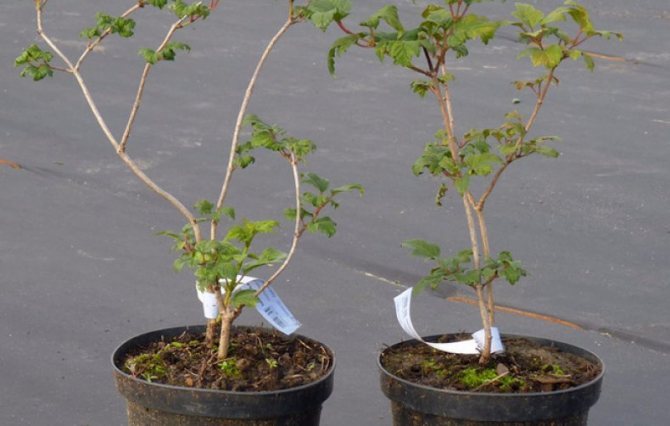

Optimal timing
Viburnum can be planted in spring or autumn. In the first case, the plant will take root well and have time to adapt to frost, and in the second, it will grow the root system and, with the onset of heat, will quickly start growing.
If you plan to plant seedlings in the spring, you need to be in time before budding on the trees. And be prepared to constantly moisturize the soil under the young plant. Autumn planting is done during the period of massive leaf fall. It is important to carry out rooting at least 2 weeks before the first frost.
Site preparation
Before planting young seedlings, you need to clear the selected place of weeds and dig up the soil well. On oxidized areas, acidity correction is recommended, which is done with dolomite flour, known fluff or old plaster.
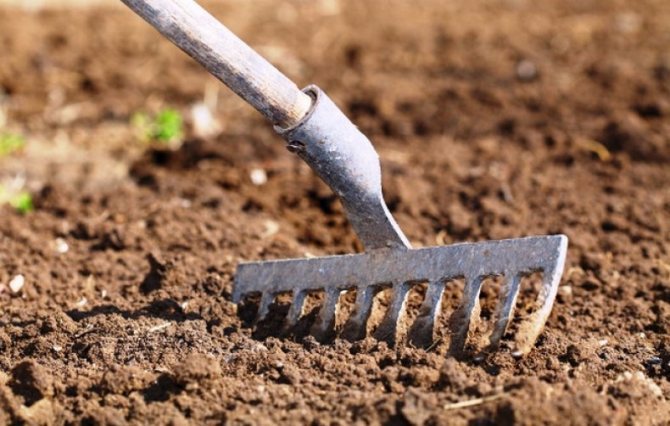

You can check the pH reaction with ordinary table vinegar. If, when a few drops hit a lump of earth taken from a 15-centimeter depth, they begin to foam and hiss - an alkaline medium is on the site. You can acidify it with citric acid.
Planting process
When the land on the site is prepared, and the roots of the seedling are processed from drying out with a special clay talker, you can proceed directly to planting. To do this, dig a hole half a meter high and wide.
Mainly focus on the size of the roots. They should not be cramped in the pit. Lower a thin layer of expanded clay or brick chips to the bottom, pour a soil mixture of equal parts of peat, humus and 60 g of mineral complex fertilizer on top.
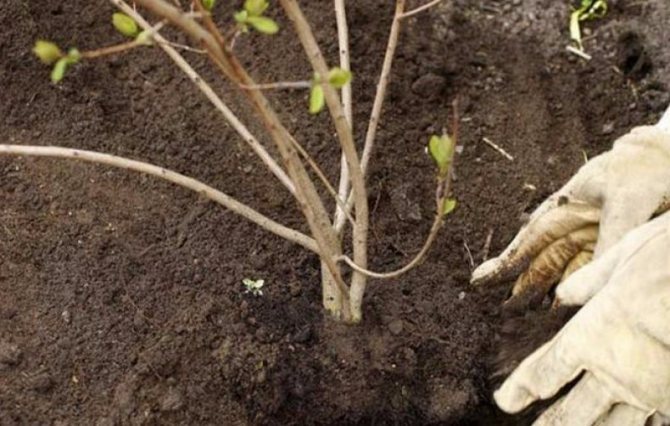

Then water the hole (in spring this should be done until the earth absorbs water), place the seedling on top, spread its roots and cover it with fertile soil.
Experienced gardeners advise shaking the trunk so that the voids formed in the roots are filled up during the planting process. Do not forget to tamp the trunk circle well after that. If you want several types of viburnum to flaunt nearby, step back from the neighboring plants at least 2 m.After all the work is completed, water the site again and mulch.
Planting viburnum
Viburnum grows in lighted places; neutral or slightly acidic soils should be chosen for it. Does not like peaty, sandy and podzolic soils. It can grow on infertile soil, but it will not bloom and bear fruit well.
Flowering viburnum
To improve the soil, it is enriched with peat and phosphorus-potassium fertilizers for about a month. It is better not to use manure in order to avoid the appearance of weeds.
Viburnum can be planted both in spring and autumn.
- The planting hole must be dug 40x50 cm, about 40-50 cm deep. The distance between the bushes (trees) of the viburnum should be about 3 meters.
- The soil mixture should consist of organic (upper soil from a pit, peat, humus) and mineral fertilizers (about 3 tablespoons of urea and a glass of wood ash or dolomite flour). Add ash in such a way that the roots do not come into contact with it.
- Seedlings with closed roots are placed in the center of the pit and sprinkled in such a way that the root collar is buried no more than 5 cm.
- Plant seedlings with open roots so that the roots are like on a tubercle of the soil mixture, distributing the roots and covering them with soil.
- After planting around the tree trunk circle, make a hole and water the plant. Next, mulch the soil with sawdust or peat.
The nuances of planting a bush in open ground
In order for the viburnum bush to grow well, it is necessary to plant the plant correctly.
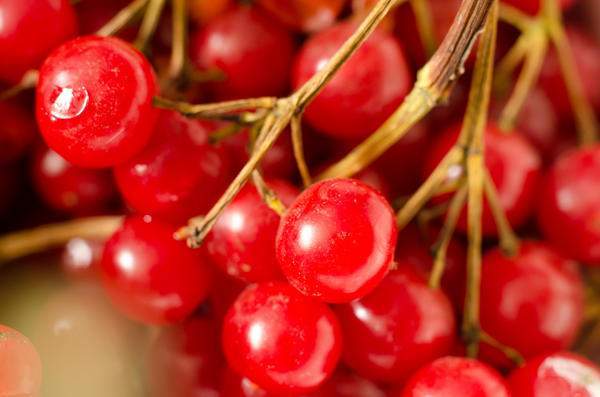

When to plant viburnum
The bush should be planted in the ground in autumn or spring, after leaf fall or before the leaves open.
In the spring
When planting in spring, a pit of 50x50 centimeters is prepared in advance, the distance between seedlings is 2.5-3.5 meters. A three-year-old seedling is used. The soil is combined with fertilizers (1 bucket of humus or peat, Nitrofoska - 2 glasses), organic matter is not added to the fertile soil.
In autumn
Viburnum is planted in the 2-3 decade of September, weeding the site, destroying weeds and grass. Autumn planting technology is the same as in spring, the main thing is that the seedlings have time to get stronger before frost.
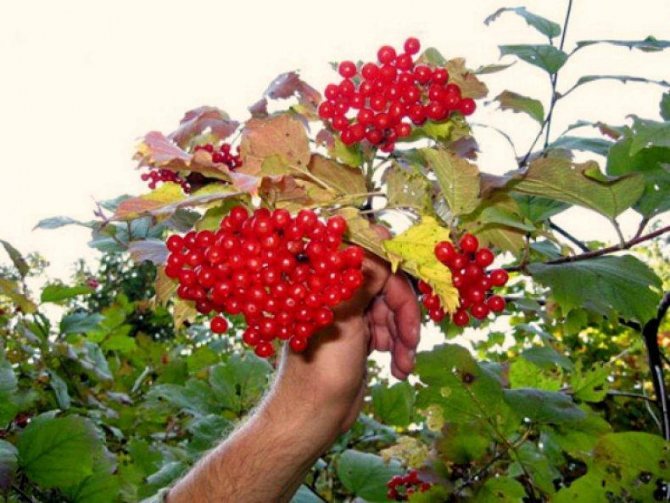

Choosing a landing site
Viburnum grows well in sunny or slightly shaded areas, the plant loves moisture, for it you should choose a site with a close location of groundwater.
Soil preparation
Kalina prefers neutral or slightly acidic soil. It grows poorly only on too heavy soil.
Viburnum planting technology
The prepared hole is filled with soil more than half, 2-4 buckets of water are poured in and left for a week to shrink the soil. Then, from the remnants of the soil, a mound is formed in the pit, in the center of which a seedling is installed. The roots should be straightened, after which the pit is filled up and compacted. The plant is well watered, the soil around is mulched.
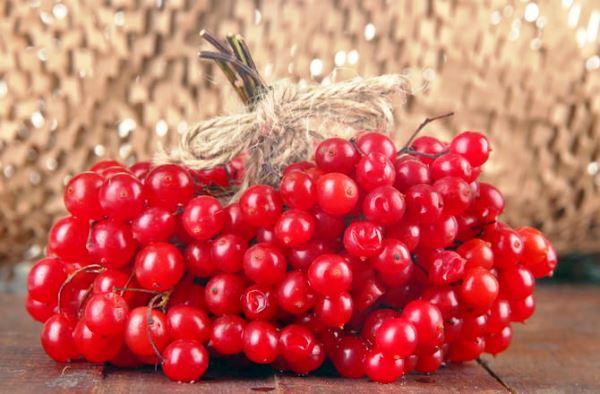

Features of planting viburnum in the fall
Planting and caring for the plant does not require special difficulties and difficulties. Viburnum grows well on neutral and weak acidity soils (pH 5.5-6.5). Sand, peat and podzolic soil are not suitable. The depth of the ground is at least one meter.
Kalina prefers that the site of its location is well lit, but it grows well in shady places. According to some experts, viburnum in the shade attracts pests less.
Viburnum is planted both in the spring, when the leaves did not appear, and in the fall, when the leaves have already fallen off. Before planting, the land is dug up and freed from weeds. Fertile soil does not need organic fertilization. Fertilize poor soil just before planting.
Before planting, a recess with a diameter of 60 cm and a depth of half a meter is dug. The distance between the pits should be at least one and a half meters. The soil from the hole is mixed with organic and mineral fertilizers. One recess requires:
- humus or peat (10 l);
- potassium sulfate (1/2 cup);
- superphosphate (1 glass);
- dolomite flour (1 glass);
- urea (2 tbsp. l.)
Everything is thoroughly mixed and poured 2/3 into the recess. Then the soil mixture is poured with 3-4 buckets of water. For 6-7 days, the fossa is moistened. During planting, the remaining mixture is poured into the hole so that a tubercle appears, the height of which should be 10-12 cm. A seedling is placed on the tubercle in an upright position, sprinkled with soil and compacted. Then a hole is made in the near-trunk circle and watering is performed.
Mulching is carried out in late spring when the soil is warm and moist. Mulch in the form of crushed tree bark, wood chips or peat is scattered around the bush.
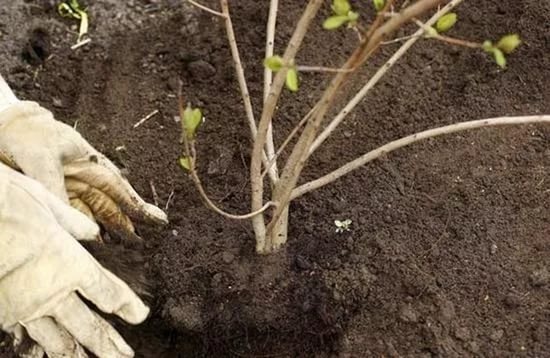

Planting a young viburnum seedling
How to care for a shrub
Viburnum in cultivation is very undemanding and grateful for the elementary conditions, in care it needs moisture, pruning, as well as preventive treatment against diseases and pests. Let's figure it out in order.
Watering, weeding and loosening the soil
Young seedlings need to be given much more attention than mature shrubs. They require frequent watering, but in small portions.
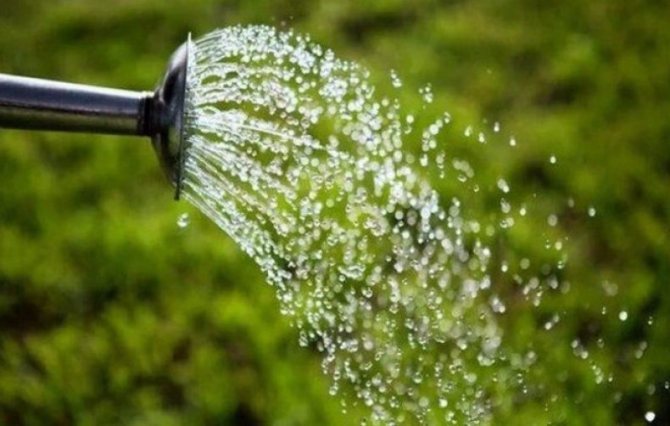

Viburnum bushes are very moisture-loving, so they should be moistened to the extent that the top layer of the earth dries out. In this case, you should not turn the near-trunk holes into swampy slurry. Excess moisture is fraught with fungal diseases and putrefactive infections.
Under these conditions, the plant is likely to wither away. The amount of water for irrigation depends on the age of the shrub and weather conditions.About two buckets of liquid are poured under three-year-old seedlings. The main thing is that the ground under the plant is soaked to a depth of half a meter.
Role of mulch
According to gardeners, the best material for mulching is compost, sawdust or peat. It is imperative to cover the soil with mulch in the near-trunk circles under the viburnum several times a year.
The best period is April-May, when the soil is still wet, but already warmed up. This is done in order to protect the roots from overheating, retain moisture and revitalize the earth with useful substances that result from the decomposition of mulch.
Agronomists advise against using coniferous hairpins and sawdust for this purpose, since they contribute to the oxidation of the substrate.
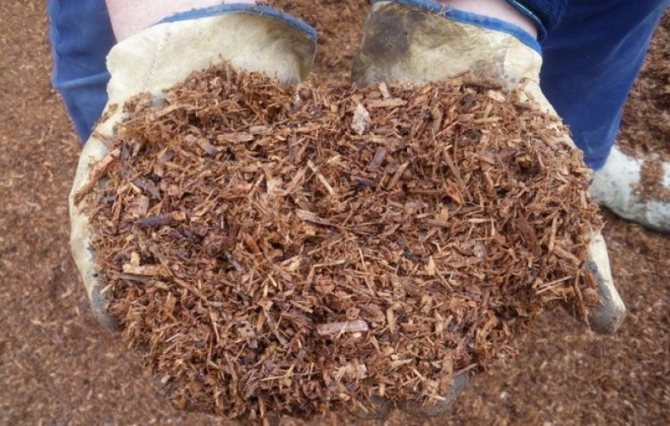

Top dressing
If you choose the right area, water and mulch it on time, then there will be no problems with fertilizing, since it is easy to care for the viburnum, and there is no need to correct the substrate.
In such conditions, it is enough to apply any organic fertilizers to the trunks every two years at the rate of 3-4 kg per square meter of area.
In the spring, when the viburnum is not yet blooming, mineral complex fertilizers are applied under the bushes, about 75-80 g for each planting hole. Agronomists advise to introduce organic matter in the fall when plowing a plot.
Preventive treatment
Every spring on the bushes of the viburnum, all apical shoots should be removed. This is done in order to destroy the clutch of eggs of the viburnum leaf beetle, leaf rollers, caterpillars, scale insects and aphids, which love to feast on the plant sap.
Pruning and shaping the crown
The above diseases are also accompanied by a strongly thickened crown. Therefore, it is important to clear the crown in time from the shoots competing with each other and directed inside the bush. After the procedure, all branches should be evenly lit and not cast shadows on each other.
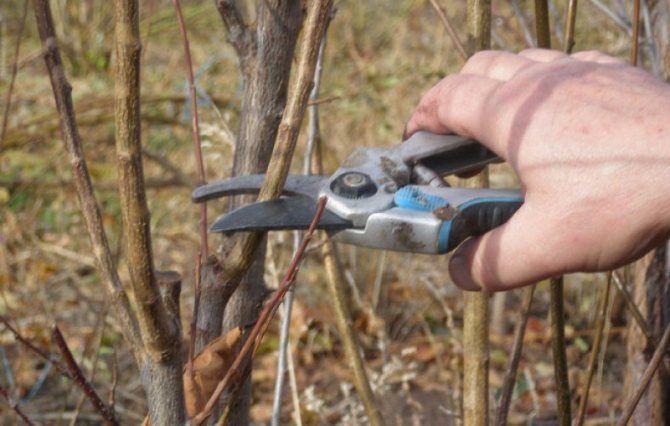

You can do a haircut both in the spring and in the fall. But most experts are prone to March pruning, when the juice has not yet begun to move. In this case, it is necessary to remove part of the old shoots, replacing it with young ones.
Of these, you need to choose the strongest and most viable specimens. And if it's time for a radical rejuvenation, cut off all the old shoots low near the ground - a developed root system will quickly build up biomass on the remaining young shoots.
This is necessary in order to activate the expansion of the crown.
Care rules
Viburnum is an unpretentious plant, but it requires basic care rules. In order to grow a healthy plant, you do not need to spend a lot of effort, time, so even a novice gardener can cope with the process. It is necessary to take care of the crop in the country or in the personal plot correctly, regularly performing processing, watering, pruning, feeding.
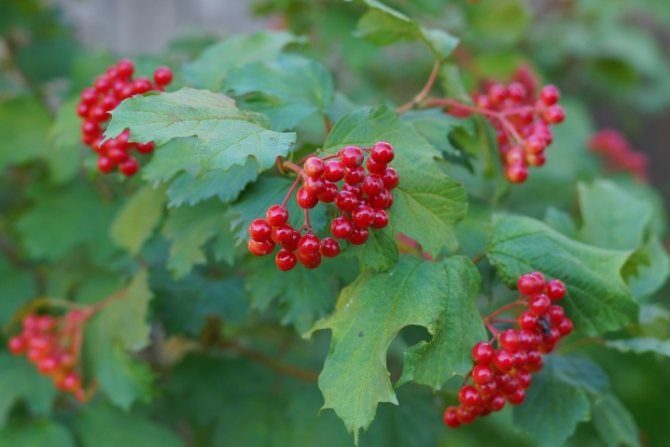

Treatment
All garden plants suffer from diseases and pests from time to time, and viburnum is no exception. For the safety of the crop, it will be necessary to carry out regular preventive spraying in the spring and autumn. Insecticides must be used to kill parasites. To eliminate fungal ailments, it is recommended to treat the bush with fungicides.
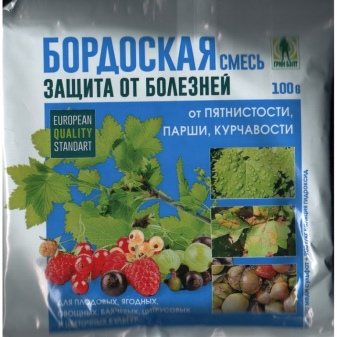

Diseases of a bacterial and viral nature are not eliminated. Gardeners should remember that all kinds of insects are capable of carrying diseases, so viburnum should be regularly treated against pests.
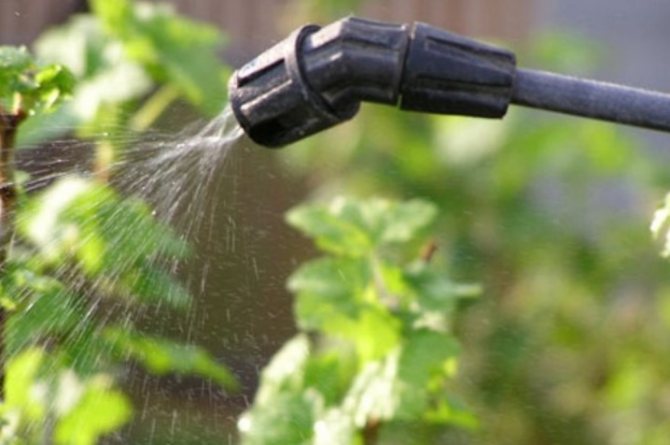

Watering
It is necessary to irrigate the viburnum bush regularly, 1 watering after 7 days is considered sufficient. Do not forget about irrigating the plant in dry, hot weather. Pour from 30 to 40 liters of liquid under one bush. A young representative of the flora does not need much water, but watering should be done once a week.
If it often rains in summer, then there should be less irrigation. However, you need to know that viburnum is a moisture-loving culture, so long breaks and overdrying of the soil should not be allowed.
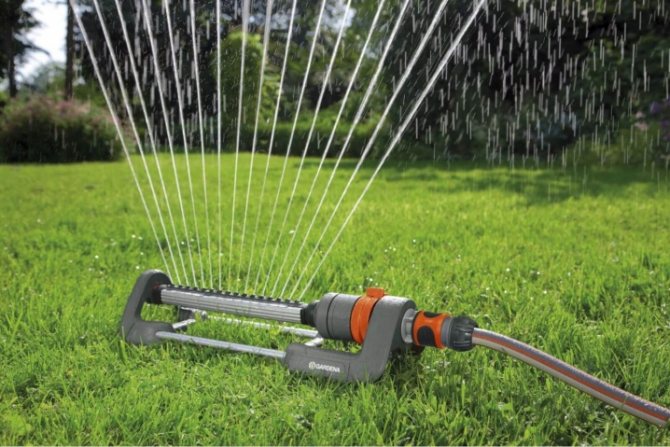

Top dressing
Due to the fact that the healing bush requires frequent watering, it must be fertilized with dry dressings. Fertilizers should be evenly distributed over the surface near the trunk circle. After the procedure, the culture should be watered. The first feeding is carried out in the spring when opening the leaves: at this time, 2 tablespoons of urea must be poured under each plant. Such a procedure is necessary only if the bush has not been fed with this substance by the kidneys in a dormant state.
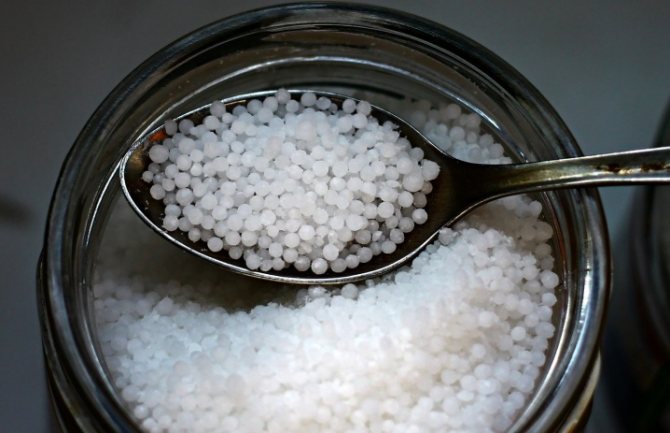

The second time, fertilizing is applied during the flowering culture. In this phase, the culture needs substances containing potassium. Under each plant, you need to add 2 large tablespoons of potassium sulfide or 0.5 liters of wood ash. The third procedure for fertilizing the viburnum is carried out after it has faded. To do this, 2 large spoons of nitroammophoska are poured under each culture.
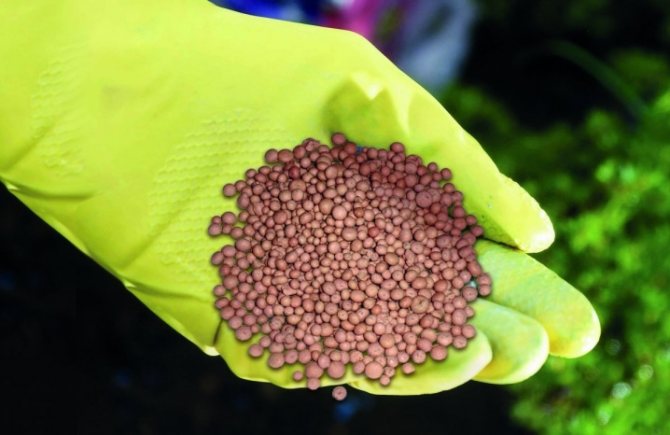

The viburnum needs the last feeding only if its near-stem circle was not covered with an organic layer before the winter period. To fertilize the bush, a solution is required, which includes a bucket of water, 2 large tablespoons of superphosphate, potassium sulfide.
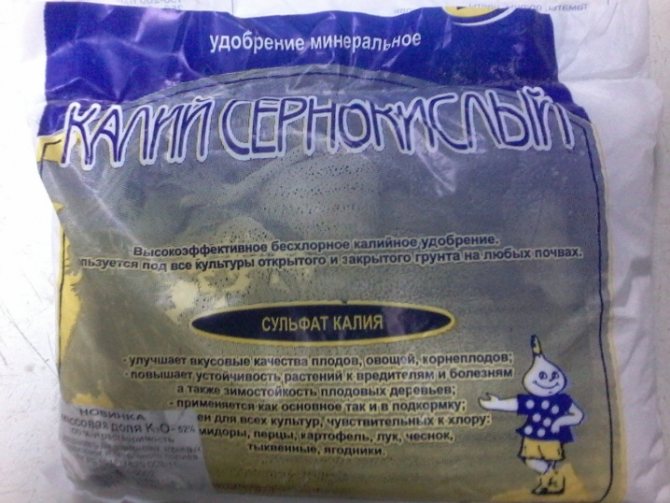

One plant needs about 20 liters of mixture.
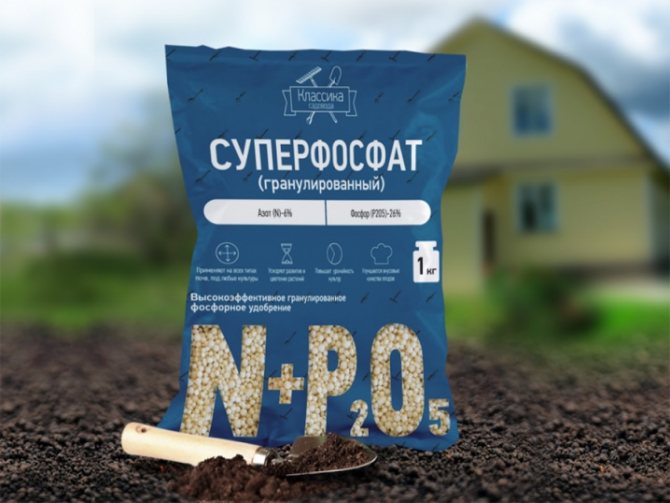

Pruning
Kalina must be trimmed in the first spring days, before the juice begins to move. A haircut can also be carried out in the autumn period after the foliage has fallen. However, experts recommend making rejuvenating and shaping pruning exclusively in the spring, and for sanitary purposes, cutting the plant in the fall.
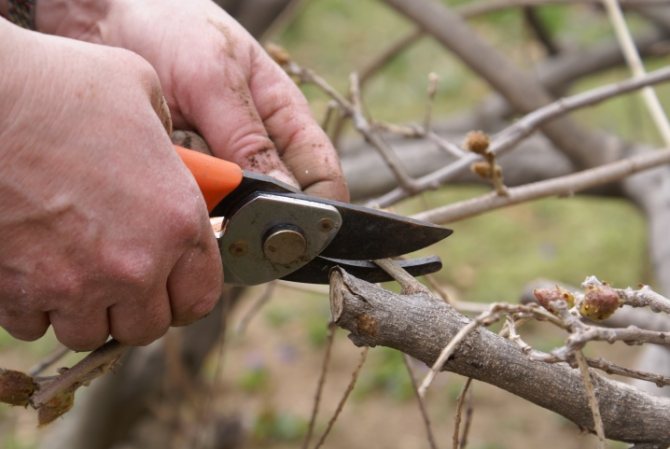

Under natural conditions, viburnum can be presented in the form of a tree or a bush, so it is worth forming its crown accordingly. Before the start of sap flow, the culture is sheared for a sanitary purpose, and after that - with a formative one. If you want the viburnum to grow in the form of a tree, you need to leave 1 vertical branch, and cut the rest into a ring. The kidneys at the bottom of the trunk, where the stem will be located, are removed.
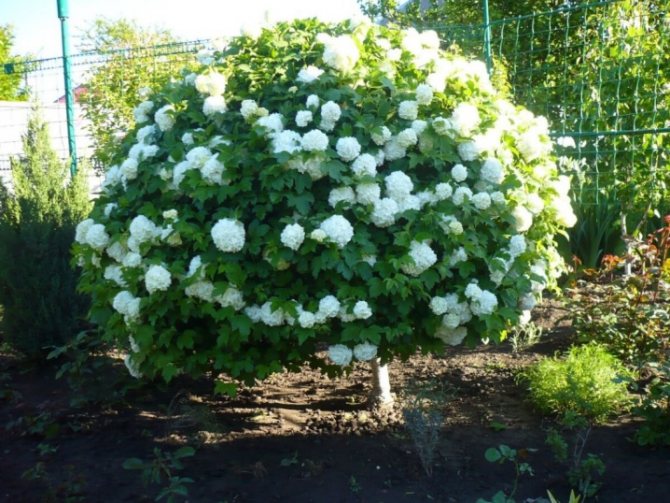

It takes about three years to remove the trunk. When the culture reaches a height of 150-200 centimeters, it is required to pinch the growth point. This procedure stimulates the branching of the plant. Throughout the entire time, it will be necessary to eliminate the growth near the roots, otherwise the result will be a shrub. Do not forget about maintaining the standard cleanliness by removing side shoots.
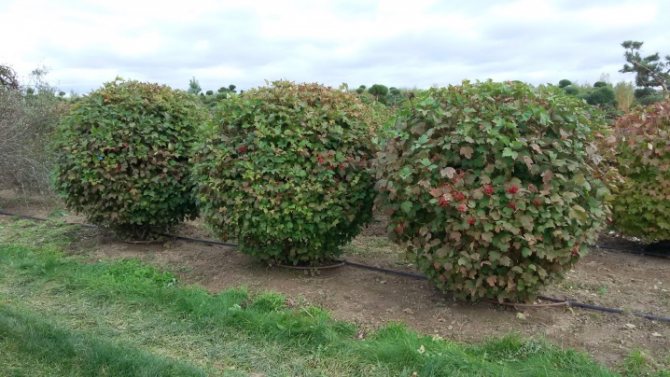

Regardless of the desire to grow a bush or tree, pruning viburnum will be required in any case. Without this procedure, the crown of the culture will grow and become thicker, which will complicate the picking of berries, worsen the quality of the fruits, and reduce their quantity. It is definitely worth pruning rival branches, as well as shoots that grow inward or incorrectly. When the need arises to rejuvenate the culture, it is worth cutting off the old shoots. At this time, only the most developed branches are left near the roots.
By the second year of the viburnum's life, it is necessary to replace another third of the obsolete branches, and by the third - the remaining third. A rejuvenating haircut of a tree culture is carried out in a similar way to other fruit trees.
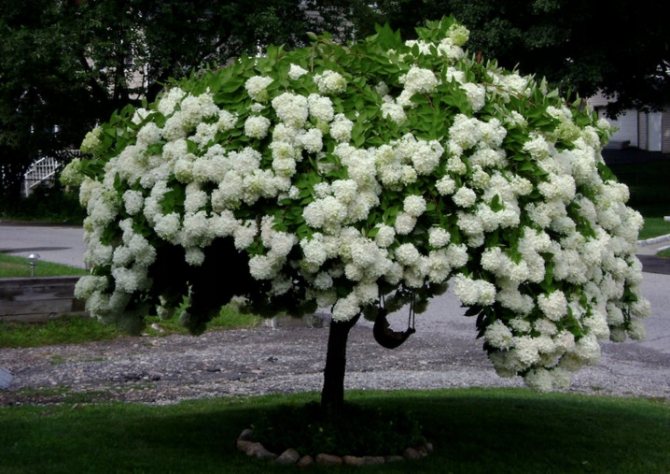

After the plant has shed all its leaves and is dormant, fall sanitary pruning can begin. In this case, it is worth removing all broken, dry branches damaged by parasites or ailments. If the cut in diameter is more than 7 millimeters, then it must be processed with garden varnish. Sanitary pruning is best done on a dry, warm fall day.
Plant care
First of all, it is worth taking care of young plants. Regardless of the degree of soil moisture, watering is carried out every seven days: 2 buckets of water for 1 short bush and 4 buckets for a large plant. Ripe viburnum is watered with high quality in spring - when young branches begin to grow and in summer - in the process of fruit ovary.
Fertilizing the soil is equally important.There are 4 stages of plant development, when it is necessary to enrich the soil for full development and a lush harvest: in the spring - during the opening of the buds, then - during the appearance and blooming of flowers, in the middle of the season, and also in the fall - during the ripening of berries.

